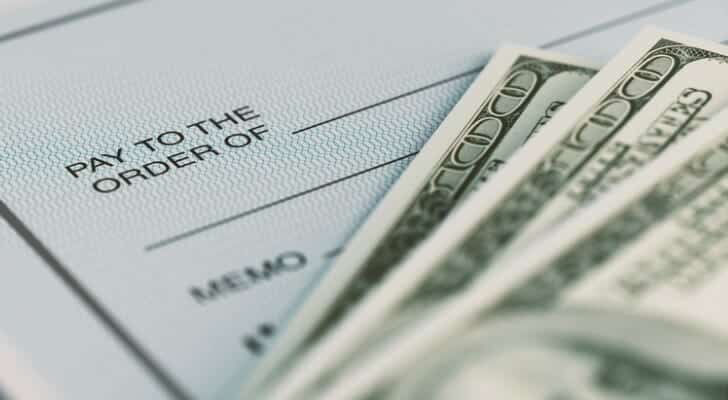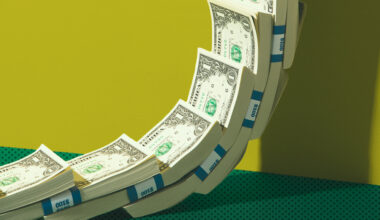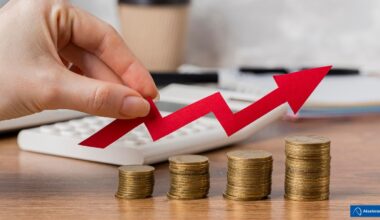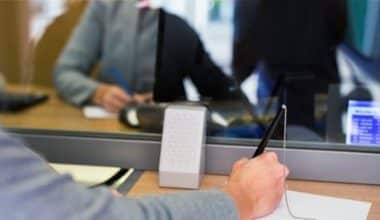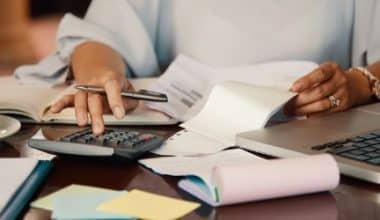Paper checks (or cheques) are still issued in our digital era of direct deposits and money transfers via smartphone apps for a variety of reasons. Even the most tech-savvy people need to cash checks from time to time. Whether it’s a grandma’s birthday check or a company or government-issued check. Knowing how to validate a check and cash it safely and cheaply will allow you to obtain your money as soon as feasible. So let’s see how to cash a check in your bank or without an account as fast as possible in this article.
Do you want to Deposit Money or get Cash?
It’s possible that you won’t need to cash a check. You can also deposit money without having to take cash. With this option, the bank deposits monies into your account, which you may then use. Only get cash if you intend to spend it soon. The funds are safe in the bank, and you will not be tempted to spend more than necessary.
Depositing the check may even be more convenient. For example, you can make deposits from nearly anywhere using a mobile device, or you can stop by an ATM during non-banking hours to deposit checks.
Prior to Cashing a Check
Check to see if the check is real before attempting to cash it. If you attempt to cash a forged or stolen check, you risk getting into legal trouble, being taken advantage of, or owing to bank fines.
Some frequent scams involve receiving a fraudulent check and then being asked to perform something, such as wire money or return cash to the check writer. For the scam to succeed, there is usually a time constraint that necessitates immediate action before the check bounces.
If you are unsure whether a check is genuine, either take it to the check writer’s bank or discuss your concerns with your bank. If you decide to deposit the check, you should plan on waiting a bit before spending the money. Bad checks can take many weeks to be discovered by your bank.
Where can I Cash a Check?
#1. The bank or credit union on the check:
You should be able to cash a check at the financial institution of the person or firm who wrote you the check. Banks and credit unions, on the other hand, are not compelled to cash checks from noncustomers. If they do, they frequently charge a fee, which can be a fixed amount (such as $8) or a percentage of the amount of the check (such as 1 percent ). Some banks may also need two kinds of identification.
#2. Major merchants and food stores:
Check-cashing services are available at many large retail chains, usually for less than $10 per check. For example, Walmart charges a $4 fee to cash checks up to $1,000 and an $8 cost for checks larger than $1,000. Kmart offers a lower-cost service of cashing checks up to a specified amount for $1 or less.
#3. The retailer that allows you to load cash onto prepaid debit cards:
Prepaid debit cards allow you to deposit a check, add it to your card’s balance, and withdraw cash. To do so, deposit the check by mobile check deposit through the card’s mobile app, if available, or by visiting a big shop that is part of a reload network, such as 7-Eleven or Walmart. Then, either at that retailer’s location or an ATM, withdraw cash.
There could be two fees in total: one to load the check onto the card and another to withdraw cash. Prepaid cards typically cost roughly $5, plus a monthly service fee of about $5.
Where should you avoid cashing a check?
Payday loan stores
This is a costly alternative because they often charge a percentage of the amount of the check you’re cashing. You’re better off using a bank, prepaid debit card, or a retail outlet.
Using Your Bank to Cash a Check
#1. Bring a valid photo ID to any of your bank’s branches.
If you have an open account with a bank of any kind, they will cash a legitimate check for you. When cashing a check in person, you may be asked to provide a valid photo ID. Typically, driver’s licenses and passports are the best options. Military or school identification may be accepted in some instances.
- Many banks prefer that you also have your bank debit card on hand. So, if you don’t have a debit card, you may be forced to fill out additional paperwork in order to cash your check.
- If you have any queries about the bank’s I.D. requirements, please contact the branch. If you cash the check at an ATM or using your smartphone, you will not be required to present a photo ID.
#2. You can cash your check at your bank’s teller.
This is the simplest way to obtain the money you’ve earned swiftly and safely. If asked, show your ID or hand over your debit card to the teller. For maximum security, never sign the back of a check before you arrive at the bank; instead, do it in front of the teller when you cash it.
#3. If necessary, deposit the check and then withdraw cash from your account.
Some banks may require you to deposit the check into your account rather than cash it. This is more likely if the check you’re attempting to cash was written on a different bank account.
- If you require cash urgently and have adequate funds in your bank account, you can deposit the check and instantly withdraw the required amount.
- If the bank on which the check is written refuses to pay your bank, the check “bounces,” and your bank must reimburse itself from your bank account. Banks will typically charge a fee for the inconvenience of dealing with a returned check.
#4. Deposit your check at one of your bank’s ATMs.
Paper checks can be easily inserted and deposited into your account using modern ATMs (Automated Teller Machines). Depending on your bank, the funds may be available right away, or you may have to wait up to three days for the cash to clear. However, if you already have enough cash in your account, you can simply withdraw the amount you require in the meantime.
- Insert your debit card.
- Enter your PIN and hit Enter.
- Choose “Deposit Check” from the drop-down menu.
- Place the check in the check deposit slot.
- Confirm the amount written on the check.
- Take out the money you require from the ATM.
#5. To cash a check, Online using a Mobile Banking App.
Many banks now let you deposit checks into your account with your smartphone. The procedure varies by bank, but it usually entails downloading the bank’s app and taking a snapshot of your check using your smartphone camera.
- Make careful to follow all of the app’s instructions.
- After you’ve signed the check, snap clear, well-lit images of its front and back sides.
- Keep the check until you get confirmation that it was deposited, then trash it.
- However, once the check clears, you will need to leave the house to withdraw the funds from an ATM or bank branch.
How to Cash a Check If You Don’t Have a Bank Account
Cashing a check is difficult for the millions of people who do not have a bank account. According to a 2017 FDIC poll, approximately 8.4 million U.S. households, comprising 14.1 million adults, do not have a bank account.
There are ways to cash a check without a bank account, but they are more expensive, take longer, and are riskier than cashing a check at a bank where you have an account. Here are five ways to cash a check without an account.
#1. Cash your check at the bank that issued it.
Although banks and credit unions are not compelled to accept checks for non-customers, many will cash a check drawn by an account holder at that bank, even if it is payable to a non-customer.
It should be noted that the payer’s account must have sufficient funds to cover the check. In addition, the payee (the person cashing the check) must present identities, such as a driver’s license or military ID.
The payee should also anticipate paying a charge. Typical check-cashing fees at traditional banks are roughly $8. If you get paid 52 weeks a year, that works up to $416 in check-cashing fees.
There may also be limitations, such as check amount limits and the refusal of two-party personal checks. Checks that are six months or older may be rejected.
#2. Take your cheque to a merchant and cash it.
Check-cashing services are available in a variety of large retail locations, including Walmart, Kmart, and grocery chains.
Kmart is probably the cheapest option (assuming you can find one that hasn’t closed yet). The failing retailer charges $1 or less to cash checks, including two-party personal checks up to $500 in value. The only catch is that you must be a member of the store’s “Shop Your Way” program to use the service. It is completely free to join the program.
Walmart charges $4 to cash checks up to $1,000 and $8 to cash checks more than $1,000. Walmart accepts two-party personal checks, but limits them to $200 and levies a $6 maximum fee.
Check-cashing services are frequently available in grocery stores. Kroger, Publix, Giant Eagle, Albertsons, and Ingles are just a few of the stores that accept checks. Fees normally range between $3 and $6.
#3. Put money on a prepaid debit card
Prepaid cards are occasionally used by people who do not have a bank account to deposit checks and cash their check. Prepaid cards are similar to debit cards for checking accounts. The amount of money you have loaded onto the card limits your spending.
Check cashing alternatives for prepaid cards vary. You may set up direct deposit on some prepaid cards so that checks are automatically put onto the card. Other cards include an app that allows you to take a picture of your check and load it onto your card. Alternatively, you may be able to deposit your check at an ATM to load the funds onto the card.
Prepaid cards have a significant disadvantage in terms of fees. The Walmart MoneyCard charges $2.50 to withdraw money from an ATM or a bank teller window (not including the bank’s fee), and 50 cents to check your card balance at an ATM.
#4. Take your cheque to a check-cashing service.
Check-cashing establishments are most likely the most expensive places to cash checks. Some of them demand clients to become “members” or purchase check-cashing ID cards before cashing checks. They may impose a first-time use fee in addition to a membership cost.
Fees for cashing a check can range from 1% to 12% of the check’s face value. That implies a $1,000 check may cost you anywhere from $10 to $120 to cash. Some companies charge a fixed fee in addition to the percentage.
According to the FDIC, the average face value of a check presented to a check-cashing outlet is $442.30. And, the average charge to cash that check is $13.77, or about 3.1 percent. If that’s your paycheck and you cash it every week, you’ll pay $55.08 in check-cashing costs per month, or $661 per year.
Check-cashing establishments are not only exorbitantly priced but there is also a possibility of misleading tactics. For example, the Better Business Bureau warns consumers against a scam in which customers of a check-cashing store are contacted by someone claiming to represent the company. The caller proposes a loan to the customer and wants cash to secure the deal. Of course, the loan is never received, and the check-cashing store customer is duped out of their money.
Check-cashing services should only be used as a last option.
#5. Give your check to someone you trust.
If you don’t have a bank account, another option is to sign the check over to someone you trust who does have a bank account and have that person cash the check at their bank.
Make certain that the individual to whom you are signing your check is willing to cash it and that his or her bank will cash it. You should go to the bank with a trusted buddy in case the teller asks for your ID or has issues with the cheque.
Your acquaintance must have proper identification and be prepared for a check-cashing charge to be deducted from his or her cheque.
There is a personal and financial safety risk in all of the approaches described above. Paper checks and cash are easily misplaced or stolen.
Related: BACK OF CHECK: How to Sign, What to Write & Wrong Endorsement Solutions
How to Cash a Check Quickly
The decision of whether to cash or deposit a check can affect how quickly you receive your funds.
You do not need to wait if you simply want to deposit the check so that your bank can begin processing the payment as soon as feasible. Most banks and credit unions enable you to deposit checks with your mobile device at any time. So, you could deposit your check online from your couch in the middle of the night if you wish.
If you need the money immediately away, cash the check. However, be aware that it may need a little extra effort, particularly if you don’t have a bank account.
#1. The Check Type Is Important
The type of check you’re attempting to cash is important. Banks are only needed to make the first $200 of a personal or commercial check available to you within one business day. They, on the other hand, treat government-issued checks differently. You typically get 100% of your cash right away since banks know the government has the funds.
Other checks, such as cashier’s checks, payroll checks from local firms, and payments from insurance companies, may also qualify depending on your bank’s standards.
If you can’t cash a check for its full face value, you might have to deposit it. In this scenario, the speed with which you can access the cash is determined by the type of deposit you make. If you need the funds fast, deposit in person to bank staff. You can also use an ATM or your mobile device to deposit money. However, these options may result in lengthy bank hold periods.
Furthermore, as unjust as it may appear, you are always liable if a check bounces—even if the bank allows you to walk out with cash or makes funds available in your account. Note that if you don’t pay for a bounced check, the bank may pursue legal action against you.
#2. Visit the Check-Bank Writer’s
Taking your check to the check writer’s bank is the safest and quickest option to acquire cash. That is the bank or credit union that holds the check writer’s funds, and you may receive the money out of the check writer’s account and into your hands promptly at that bank. If you go to another bank, you can’t be sure that the check is valid and that the money is in the check writer’s account.
The bank’s name or emblem can be found on the front of the check. You are not required to visit the same branch as the check writer; you may visit any branch of the same bank. Make sure you bring identification that matches the name on the check.
If you don’t have an account at that bank, you may have to pay a few dollars to have the check cashed. You may even discover that the bank refuses to pay the check because you are not a customer. Furthermore, depending on the size of the check, you may be unable to cash it because certain banks have a restriction on the amount of cash they can discharge. Going to one of the bank’s larger branches, which normally have more funds accessible, will help.
#3. Try Your Own Bank
If you have your own bank or credit union, you may be able to cash a check there if:
- You are not concerned about the check bouncing or being returned because the check writer lacks sufficient funds to cover the check.
- The check was drawn for less than $200, or it is a government-issued check.
- You do not wish to pay any fees.
Because you are a customer, your bank should cash the check for free. However, it will take several days for the check to clear, so you won’t know right immediately if the check will bounce. In most circumstances, banks will enable you to withdraw up to $200 instantly or within one working day, if nothing appears to be suspicious. However, if the check bounces, you must reimburse the money plus a fee (which can range between $25 and $30).
Using an ATM to Cash a Check
It’s a little more complicated than going to a bank, but you can also cash a check at an ATM. However, not every ATM will provide this choice; some will merely allow you to deposit the check, while others will not accept check deposits at all.
If a local ATM enables it, simply bring your check, bank card, and a pen (to endorse the check) to the machine and follow the steps on the screen. Before the ATM will dispense your cash, you may need to have the amount of the funds currently available in your account.
Retailers and Check-Cashing Facilities
If your bank is closed, will not cash your check, or will not give you more than $200 in cash, you might try to get cash from a retailer. You’ll have the best luck with a government-issued or payroll check, although tiny personal checks may also be accepted.
Checks are frequently cashed at big-box stores, supermarket stores, and convenience stores for a little fee—usually a few dollars. They normally cap the number of personal checks they’ll cash at $50 or $100; Kmart is exceptional in that it will cash checks up to $500 and charges no fee in some areas and only a dollar in others. The majority of retailers accept government checks, payroll checks, and money orders.
However, if you have a little personal check (less than $25), you can always ask someone at the customer service desk whether an exception can be made, especially if you’re a regular customer. But be prepared to get turned down.
Check-cashing establishments are another alternative for cashing personal checks; these establishments are often open later than banks and will cash larger checks than retailers. Check-cashing establishments, on the other hand, typically charge a large fee in addition to a percentage of the value of the check.
How to Cash Postdated Checks
In most circumstances, if you receive a check with the next week’s date printed on it, you can disregard the fact that the check is postdated. However, there’s a good chance the check writer postdated the check because the funds aren’t yet available. Depending on how well you know the check writer, you’ll have to decide on when to cash it.
Other Options to Cash Checks
Check-cashing, cash advance, and payday loan businesses can also cash checks. However, they often charge exorbitant rates, so it’s recommended to avoid those establishments. The costs mount up over time, and you end up with less money to spend.
You’ll generally receive a better deal (or avoid fees entirely) if you create an account at a bank or credit union. Open a bank account if you receive more than a few checks per year. If you have a bank account, you will most likely save a lot of time in addition to money on fees. For example, instead of going to a check-cashing store, you can utilize a bank’s or credit union’s mobile deposit option to deposit checks with your mobile device.
Many grocery stores and supermarkets allow you to cash a check, and they are usually less expensive than check-cashing establishments. Prices could range between one and three dollars (or less). Inquire about money services at the front of the store’s customer service desk.
If creating a bank account is not an option, try a prepaid card account. Some prepaid cards even allow you to deposit checks using your mobile phone and may not incur monthly fees. You can then use the card to withdraw cash or make purchases, however, you may need to wait for the check to clear before spending the entire amount.
Take the time to become familiar with all of the branches that are available to you, including ATMs that accept deposits. Members of credit unions may have additional options: If your credit union is part of a shared branching network, you can cash checks at thousands of locations across the country.
Cashing in with Other Banks, Businesses, or Individuals
#1. Go to the bank where the check was issued.
The name of the bank can be found on the front of the check. Most banks will cash checks written on suitably funded accounts at their bank (and may be legally compelled to do so). If you do not have an account with them, the bank may charge you a fee.
- If you do not have an account there, you must cash the check-in person with a bank teller (not an ATM). You may be required to present a valid photo ID, so bring one with you.
- If the account on which the check is written does not have enough funds to cover the check, the bank is not compelled to cash it.
- Some states in the United States have legislation requiring banks to cash checks drawn on their accounts without charge.
#2. You can cash your check at any major merchant.
Large grocery chains and general item businesses (such as Walmart) frequently allow you to cash company or payroll checks for a small fee; some, but not all, may also cash personal checks. This may be less expensive than doing the same activity at a bank where you don’t have an account or at a cash-checking service.
- Just as when you go to the bank, don’t sign the back of your check until you’re in front of the person who will cash it for you.
- Some businesses may need you to join their rewards or loyalty program, although these are almost always free and simple to sign up for.
#3. With a prepaid debit card, you may deposit and withdraw money from ATMs.
Prepaid debit cards are now available from several financial institutions to consumers who do not have bank accounts. If you have a prepaid card, you can usually deposit checks at certain ATMs. Depending on the card, you may be charged a fee to deposit and withdraw funds.
- Visa, for example, offers a reloadable “Payroll Card” that you can obtain through your job. Checks can be deposited and withdrawn at any ATM that accepts Visa debit cards.
- Prepaid debit cards are also available from many large banks. For a monthly cost of about $5 USD, Chase offers a prepaid card that allows you to deposit checks at any Chase ATM.
- Prepaid cards are typically issued by large financial institutions such as MasterCard and American Express.
#4. If you don’t have any other options, go to a specialized check-cashing company.
Because these companies charge the greatest money for cashing personal and payroll checks, you should only use this approach as a last resort. On the plus side, these stores are frequently the quickest option to obtain the majority of your money right away. However, the commission charged by these check-paying establishments is high — typically more than 10% — due to the additional risk they incur by cashing nearly all checks brought to them.
- These establishments are aware that they are dealing with consumers who require the money from the check as soon as possible and, as a result, can charge them exorbitant fees.
- Check-cashing services may be your only alternative if you do not have a bank account and require cash instantly from a personal check.
#5. Sign the check over to someone you trust.
By signing the back of your check to someone you trust and know well, they can go into their own bank, cash it, and hand you the money just as quickly. The caveat here is that you should only ask someone you absolutely trust to do this for you. In most situations, you should accompany them to the bank when they pay your check, though you are not required to be present.
- To endorse the check to another person, write “Pay to the order of _” on the backside of the check. Fill in the blanks with your name. You may also be asked to initial near the written and numerical amounts on the front of the check-in some situations.
- Never ask someone you don’t know well to cash a check on your behalf. Never cash a check for someone you don’t know well and trust completely.
Taking Precautions When Cashing Checks
#1. Make sure you trust the individual who wrote you the check.
If you receive a faulty check, it will be far more difficult to recover the money that is rightly yours. If you’re asking for money from someone you’ve never met before, it’s best to ask for it in cash. However, if you do have a check, ensure that you have the necessary information:
- The correct first and last name, as well as the address, of the individual handing you the check.
- Contact information for the person who wrote you the check, in case you have difficulties cashing it.
- The name of a genuine bank from which the check is drawn.
- Check with the issuing bank to ensure that the individual writing the check has a checking account with sufficient funds to cover it. If you contact the bank, they will usually verify the account from which the check was drawn.
#2. Ascertain that the check is correctly made out to you.
Your name must be appropriately printed on the check. Banks may refuse payment if the name on the check does not match the individual attempting to cash it. Request that the name on the check matches the name on your legitimate photo I.D. (driver’s license, etc.).
#3. Look for any issues with check endorsement.
The information on the check must be complete and correct. This comprises the payment date, amount, and signature. If the information is incorrect or missing, you will most likely be unable to cash it.
- The date indicated on the check is the first day the monies can be withdrawn.
- Below the date is a numerical amount box. It denotes the precise amount to be paid. Check that this is the proper amount owed and that it corresponds to the written dollar amount to the left of the box.
- The signature of the owner of the account from which the monies will be withdrawn is required for the check to be valid.
#3. Just as you’re about to cash the check, sign it.
Simply flip the check over and sign the line with the “x” to the left of it to endorse it. Do this right before going to the ATM or bank, so your check cannot be cashed as readily if you lose it.
- If there are multiple payees — for example, “Pay to the order of Jackson and Leanna Teller” – all payees must endorse the check in order for it to be cashed.
- A check, on the other hand, can be placed into a joint account with only one of the joint owners signing.
- Unless there are specific limits, once a check is endorsed, it becomes a “bearer” instrument that anybody (in theory) can cash.
#4. You should cash the check as quickly as possible.
Some checks, such as those issued by employers, contain an expiration date. Even if they don’t include an expiration date, banks aren’t always compelled to accept checks six months after they were written. As a result, you should cash them as soon as possible to ensure that you get the money you deserve as swiftly and conveniently as feasible.
What happens if I try to cash a bad check?
If you try to cash a bad check, the bank will typically return the check as insufficient funds. You may also face legal consequences if the check was written with the intent to defraud.
Can I cash a check made out to someone else?
Yes, you can cash a check made out to someone else if you have the proper endorsement. The person who the check is made out to must endorse the back of the check and write “Pay to the Order of [Your Name]” and sign their signature.
What do I need to do if the check bounces?
If a check bounces, you will need to return the funds to the person who wrote the check. You may also face penalties or legal consequences if the check was written with the intent to defraud.
Can I cash a check without an ID?
It is possible to cash a check without an ID, but it will depend on the institution and the type of check. Some check-cashing services may require a valid government-issued ID, while others may not.
How do I deposit a check into my account?
To deposit a check into your account, you can either use a mobile app, deposit the check at an ATM, or deposit the check at a teller window. You will need to endorse the back of the check and provide your account information.
Can I cash a check at an ATM?
Yes, you can cash a check at an ATM if your bank offers this service. You will need to endorse the back of the check and follow the instructions on the ATM screen.
Can I cash a money order at a bank?
Yes, you can cash a money order at a bank if you have an account there. You may also be able to cash a money order at a check-cashing service.
How to Cash a Check FAQ’s
Can you cash a check at any bank?
There is no legal requirement for banks and credit unions to cash checks for everyone, especially non-customers. Nonetheless, many banks around the country will cash your checks. Your initial port of call should be the bank that issued the check.
How do I cash a check for the first time?
Simply sign the back of the check, provide your member or account numbers, and hand the check to a teller. Depending on your existing balances, you may be able to walk out with the cash you require, but keep in mind that you may have to wait up to 5 days for your check to clear before receiving your money.
Can I deposit a check on Cash app?
Checks can be deposited using the Cash App. Cash a Check will allow users to take a snapshot of a check and deposit it into their Cash App account using their mobile device’s Cash app. Use Mobile Check Capture to get funds deposited directly into your Cash App wallet.
What happens if I don’t cash my stimulus check?
If the check was not cashed, the IRS will reissue it to you. If you discover the original check after receiving a fresh payment, you must promptly return it.
- BACK OF CHECK: How to Sign, What to Write & Wrong Endorsement Solutions
- Check Card Balance: How to check card balance(+ Quick Guide).
- How to Endorse a Check for Mobile Deposit: All you Should Know
- Voided Check: All You Need to Know(+ Set up Guide for Direct Deposit)
- How do Money Orders Work? (+How to Buy with Debit Cards)
